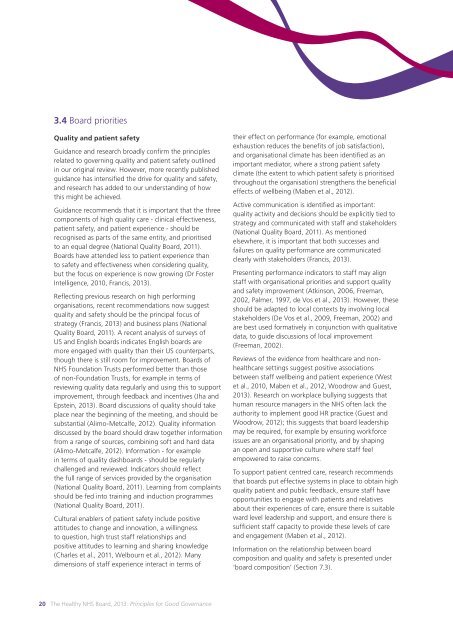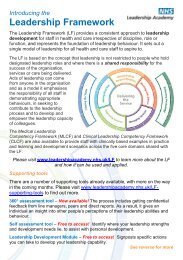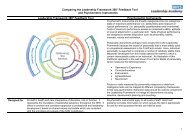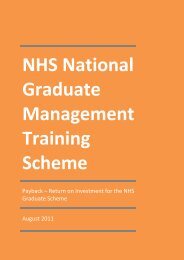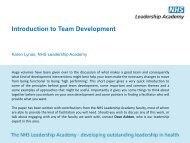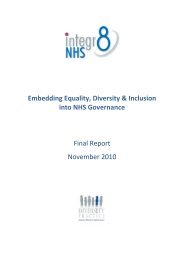Healthy NHS Board: a review of - NHS Leadership Academy
Healthy NHS Board: a review of - NHS Leadership Academy
Healthy NHS Board: a review of - NHS Leadership Academy
Create successful ePaper yourself
Turn your PDF publications into a flip-book with our unique Google optimized e-Paper software.
3.4 <strong>Board</strong> priorities<br />
Quality and patient safety<br />
Guidance and research broadly confirm the principles<br />
related to governing quality and patient safety outlined<br />
in our original <strong>review</strong>. However, more recently published<br />
guidance has intensified the drive for quality and safety,<br />
and research has added to our understanding <strong>of</strong> how<br />
this might be achieved.<br />
Guidance recommends that it is important that the three<br />
components <strong>of</strong> high quality care - clinical effectiveness,<br />
patient safety, and patient experience - should be<br />
recognised as parts <strong>of</strong> the same entity, and prioritised<br />
to an equal degree (National Quality <strong>Board</strong>, 2011).<br />
<strong>Board</strong>s have attended less to patient experience than<br />
to safety and effectiveness when considering quality,<br />
but the focus on experience is now growing (Dr Foster<br />
Intelligence, 2010, Francis, 2013).<br />
Reflecting previous research on high performing<br />
organisations, recent recommendations now suggest<br />
quality and safety should be the principal focus <strong>of</strong><br />
strategy (Francis, 2013) and business plans (National<br />
Quality <strong>Board</strong>, 2011). A recent analysis <strong>of</strong> surveys <strong>of</strong><br />
US and English boards indicates English boards are<br />
more engaged with quality than their US counterparts,<br />
though there is still room for improvement. <strong>Board</strong>s <strong>of</strong><br />
<strong>NHS</strong> Foundation Trusts performed better than those<br />
<strong>of</strong> non-Foundation Trusts, for example in terms <strong>of</strong><br />
<strong>review</strong>ing quality data regularly and using this to support<br />
improvement, through feedback and incentives (Jha and<br />
Epstein, 2013). <strong>Board</strong> discussions <strong>of</strong> quality should take<br />
place near the beginning <strong>of</strong> the meeting, and should be<br />
substantial (Alimo-Metcalfe, 2012). Quality information<br />
discussed by the board should draw together information<br />
from a range <strong>of</strong> sources, combining s<strong>of</strong>t and hard data<br />
(Alimo-Metcalfe, 2012). Information - for example<br />
in terms <strong>of</strong> quality dashboards - should be regularly<br />
challenged and <strong>review</strong>ed. Indicators should reflect<br />
the full range <strong>of</strong> services provided by the organisation<br />
(National Quality <strong>Board</strong>, 2011). Learning from complaints<br />
should be fed into training and induction programmes<br />
(National Quality <strong>Board</strong>, 2011).<br />
Cultural enablers <strong>of</strong> patient safety include positive<br />
attitudes to change and innovation, a willingness<br />
to question, high trust staff relationships and<br />
positive attitudes to learning and sharing knowledge<br />
(Charles et al., 2011, Welbourn et al., 2012). Many<br />
dimensions <strong>of</strong> staff experience interact in terms <strong>of</strong><br />
their effect on performance (for example, emotional<br />
exhaustion reduces the benefits <strong>of</strong> job satisfaction),<br />
and organisational climate has been identified as an<br />
important mediator, where a strong patient safety<br />
climate (the extent to which patient safety is prioritised<br />
throughout the organisation) strengthens the beneficial<br />
effects <strong>of</strong> wellbeing (Maben et al., 2012).<br />
Active communication is identified as important:<br />
quality activity and decisions should be explicitly tied to<br />
strategy and communicated with staff and stakeholders<br />
(National Quality <strong>Board</strong>, 2011). As mentioned<br />
elsewhere, it is important that both successes and<br />
failures on quality performance are communicated<br />
clearly with stakeholders (Francis, 2013).<br />
Presenting performance indicators to staff may align<br />
staff with organisational priorities and support quality<br />
and safety improvement (Atkinson, 2006, Freeman,<br />
2002, Palmer, 1997, de Vos et al., 2013). However, these<br />
should be adapted to local contexts by involving local<br />
stakeholders (De Vos et al., 2009, Freeman, 2002) and<br />
are best used formatively in conjunction with qualitative<br />
data, to guide discussions <strong>of</strong> local improvement<br />
(Freeman, 2002).<br />
Reviews <strong>of</strong> the evidence from healthcare and nonhealthcare<br />
settings suggest positive associations<br />
between staff wellbeing and patient experience (West<br />
et al., 2010, Maben et al., 2012, Woodrow and Guest,<br />
2013). Research on workplace bullying suggests that<br />
human resource managers in the <strong>NHS</strong> <strong>of</strong>ten lack the<br />
authority to implement good HR practice (Guest and<br />
Woodrow, 2012); this suggests that board leadership<br />
may be required, for example by ensuring workforce<br />
issues are an organisational priority, and by shaping<br />
an open and supportive culture where staff feel<br />
empowered to raise concerns.<br />
To support patient centred care, research recommends<br />
that boards put effective systems in place to obtain high<br />
quality patient and public feedback, ensure staff have<br />
opportunities to engage with patients and relatives<br />
about their experiences <strong>of</strong> care, ensure there is suitable<br />
ward level leadership and support, and ensure there is<br />
sufficient staff capacity to provide these levels <strong>of</strong> care<br />
and engagement (Maben et al., 2012).<br />
Information on the relationship between board<br />
composition and quality and safety is presented under<br />
‘board composition’ (Section 7.3).<br />
20 The <strong>Healthy</strong> <strong>NHS</strong> <strong>Board</strong>, 2013: Principles for Good Governance


